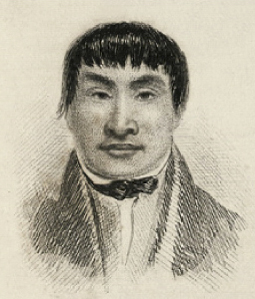Elleparu was one of the Alakaluf, or canoe people from the western part of Tierra del Fuego. He was captured by Robert FitzRoy, captain of HMS Beagle, in 1830 after one the small boats used for surveying the narrow inlets of the coast of Tierra del Fuego had been stolen. During a relentless hunt for the lost vessel, several Fuegians were taken hostage by FitzRoy, who promised their release on the return of the boat. In the end, he kept only one hostage, a young girl called Yokcushlu. During his search for the boat, FitzRoy realised the need to become better acquainted with the Fuegian language. He therefore decided to take another Fuegian captive, to act as an intermediary between the English and the indigenous people of Tierra del Fuego. He chose Elleparu, the youngest man in the first canoe that drew up alongside the Beagle in Christmas Sound. Elleparu was called York Minster by the crew because he was picked up close to a spectacular promontory on the coast named after the cathedral.
On board, Elleparu, about twenty-six years old and described as stout and very strong, was washed and given European clothes. He was sullen unless in the company of Yokcushlu or a second man captured by FitzRoy, who came to be known as Boat Memory. All three belonged to the Alakaluf tribe from the west of the country, but when FitzRoy realised that the peoples of Tierra del Fuego comprised several tribes with different languages, he decided to take a fourth captive from another group, in order to improve his chances of establishing communication. He selected a fourteen-year old Yahgan boy named Orundellico, who was called Jemmy Button by the Beagle crew. The Yahgan were enemies of the Alakaluf, so Elleparu and the others taunted Orundellico when he first came on board. FitzRoy saw this incident as 'droll', and it did not stop him from formulating a plan to educate and instruct in religion his Fuegian captives in England in the hope that this would have positive consequences when they returned to their homeland.
By the time the Beagle reached England, the Fuegians had created a good impression among the crew, except for Elleparu, whom FitzRoy regarded as a 'displeasing specimen of uncivilized human nature' (Narrative 2: 2). While being educated at Walthamstow infants' school, both Yokcushlu and Orundellico made friends and were quick to learn, but the much older Elleparu, more isolated following Boat memory's death, was seen as uncooperative, surly, and stubborn. Moreover, Elleparu began to take an obssessive interest in Yokcushlu, and during the return voyage to Tierra del Fuego they were betrothed, even though Yokcushlu appeared to like Orundellico better.
When bad weather prevented FitzRoy from returning Elleparu and Yokcushlu to the Alakaluf region in western Tierra del Fuego, Elleparu insisted that they disembark in Orundellico's home area togerher with the missionary Richard Matthews. Within days, however, FitzRoy decided that it was too dangerous for Matthews to remain in Tierra del Fuego. After some time in the Yamana region, Elleparu and Yokcushlu decided to return to their own country. Elleparu persuaded Orundellico and his mother to come with him, only to abandon them en route and steal all their belongings. FitzRoy believed that Elleparu had this in mind when he asked to disembark with Orundellico.
Little more is heard of Elleparu. Orundellico later mentioned that Elleparu had cried over the death of Boat Memory, and, in Darwin's opinion, Elleparu came the closest to expressing a religious feeling when he warned of retribution in the form of violent weather for wasteful or evil acts. In the end, Elleparu experienced a far worse form of retribution for treachery: in 1873, his wife, Yokcushlu, reported that he had been killed in retaliation for having murdered a man.
References:
Chapman, Anne. 2010. European encounters with the Yamana people of Cape Horn, before and after Darwin. Cambridge: Cambridge University Press.
Hazlewood, Nick. 2000. Savage. The life and times of Jemmy Button. London: Hodder and Stoughton.
Darwin, C. R. 1845. Journal of researches into the natural history and geology of the countries visited during the voyage of H.M.S. Beagle round the world, under the Command of Capt. Fitz Roy, R.N. 2d edition. London: John Murray.
Narrative: Narrative of the surveying voyages of His Majesty's ships Adventure and Beagle, between the years 1826 and 1836. [Edited by Robert FitzRoy.] 3 vols. and appendix. London: Henry Colburn. 1839.
ODNB article: https://doi.org/10.1093/ref:odnb/72137



